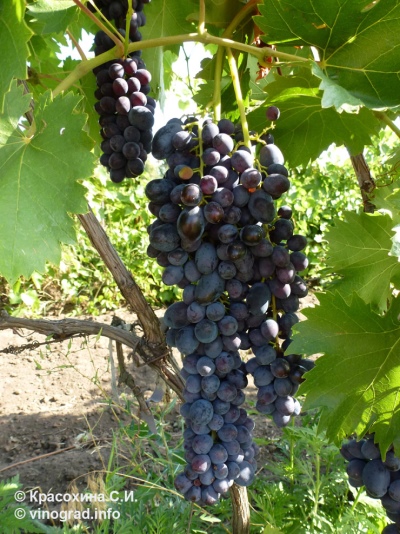
- Authors: VNIIViV Potapenko, Novocherkassk, Russia
- Appointment: dining room
- Berry color: dark purple
- Taste: harmonious
- With bones: Yes
- Ripening period: very early
- Ripening period, days: 95-105
- Frost resistance, ° C: -22
- Name synonyms: II-7-7-1
- Bunch weight, g: 400-600
A grape called Yasya has not only a delicate name, but also many benefits. They relate to the taste of berries, their appearance and positive feedback from winegrowers.
Breeding history
The first name of this unusual hybrid for dining purposes sounds like a code: II-7-7-1. The crossed form appeared as a result of the work of a group of scientists, employees of the V.N. Ya. I. Potapenko in Novocherkassk, Russia. The "parents" of the novelty were two varieties: Ogonyok Tairovsky and Rusven.
Description
Yasi is characterized by rapid growth when grown in warm climates. In cool climates, growth is moderate. The shoots of the hybrid variety are curly, very hardy, withstanding the weight of massive bunches well.
Ripening period
Yasya belongs to very early grape varieties. The ripening period is 95-105 days. In the southern regions, full ripening of the berries can be expected by the end of July.
Bunches
The attractive hybrid variety is cylindrical in shape. They have an average density. The weight of an individual bunch reaches 400-600 g.
No peeling of berries is observed when the brushes are not loaded. All berries are almost the same size.
Berries
The oval fruits of Yasi are dark purple in color. Pits are rarely found in beautiful berries. There is approximately 1 seed for 10 berries. The berry weighs about 4-6 g. It is considered large in size.
Taste
The grapes of this hybrid form have a harmonious sweet and sour taste. A pleasant balance is maintained thanks to sugar in the amount of 170-180 g / dm3 and acidity of 6-7 g / dm3.
Under the thin skin of medium density, Yasi has a tasty fleshy juicy flesh.
Yield
Almost every shoot is fruitful, so the yield of such a vine can be considered high.


Growing features
It is advisable to plant grapes in the spring season. Warm weather reduces stress on the transplanted seedling.
Landing
It is necessary to prepare a place for landing in advance. The pit must be at least 60 cm deep. The soil is loose, always warm, containing ash, humus and superphosphate.
The roots need to be straightened, which will accelerate their growth. It is important to spill the hole well with water before planting and after its implementation. Before planting, the seedling will have to be soaked in clean water for several days. The prepared shoot should have 4 to 6 eyes.
Planting in the autumn season must be done before the onset of the first frost and cooling of the soil. Be sure to cover the young plant. Planting holes need mulching.

Pollination
Yasya blooms with bisexual inflorescences. The grapes do not need other pollinating plants.
Pruning
It is advisable to carry out this process in the fall. When pruning, remove all excess and dry shoots. The remaining 6 buds are enough to ensure a good ripe crop.

Watering
This stage of leaving is of great importance. Do not allow the soil under the vine to dry out. This will negatively affect the yield of the variety and its taste.


Top dressing
To improve the size of berries and taste properties of Yas grapes, treatment with phytohormones is shown. This contributes to the production of berries that are almost the same in size, distinguished by a beautiful elongated shape.
In addition, their maturation is accelerated, and the bones disappear. Processing is carried out once, choosing for this period when the flowers have blossomed 100%.
For processing, a solution of GA-3 30-40 mg / l is used. Re-processing the grapes is not recommended, as this can significantly impair the transportability of the bunches.
Frost resistance and the need for shelter
Yasi vine can withstand up to -22 degrees. But for the winter it is recommended to cover it, especially in regions with severe frosts and winds.

Diseases and pests
Thanks to the parental varieties, the Yasya hybrid is not deprived of good immunity to diseases characteristic of grapes. Resistance to mildew and powdery mildew 1 point (high resistance). Therefore, he does not need a special reusable insecticide treatment.
But treatment from pests and wasps will not hurt. This approach helps to reduce crop loss.

If a grape is exposed to any disease or insect, this always affects its appearance.
Storage
Yasya grapes tolerate long-term transportation and storage quite well. There is only one thing. After treatment with phytohormone, the stalk hardens. Because of this, the berries may crumble during transportation.
Review overview
In the culinary field, this mixed variety is used both fresh and processed. Desserts are made from it, berries are added to fruit salads and they are supplemented with vegetable and meat snacks.
Grapes are used in sauces, syrups, they are put in the filling of pies. Baking is decorated with berries.
The seedless variety is suitable for making raisins. Natural juice and light alcohol are obtained from berries.
Berry juice has antipyretic properties and can improve blood composition. The Yasya variety contains a large amount of a substance that prevents the aging of the body and the development of cancers. Its main action is to restore metabolism and debug the immune system.
The number of advantages of this variety significantly exceeds the available minor disadvantages.The berries are large, grapes can be grown even in cold regions, and taking preventive measures, in general, do not worry about the health of the plantings.
The hybrid grape form is interesting for winegrowers who are ready to pay attention and time to painstaking manual processing of inflorescences to obtain raisins of an early harvest of berries of a very unusual shape.











































































